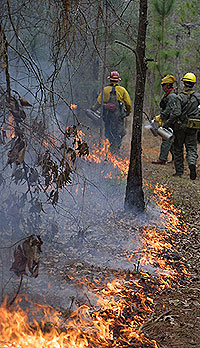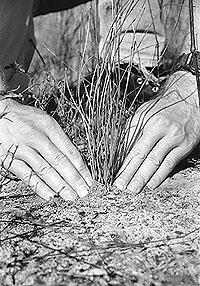|
History Animals & Plants Natural Communities Management Management Goals Management Tools References |
Natural Communities Management:
Management Tools
 Starting a prescribed fire with drip torches. (Photo by Karla Brandt)  After a prescribed fire, a crew member puts out a smoldering stump. The hose is attached to a water tank on the back of a pickup truck. (Photo by Karla Brandt) |
Fire: Many of the upland natural communities in the ARROW region require fire to maintain their plants and animals. Some plants cannot grow from seed unless their seeds find an open patch of ground without competition from other plants. Fire, applied correctly, can supply these little patches. Other plants don't flower, or don't flower as much, if they are not burned at the right time of year. Wiregrass, the foundation plant of the sandhills, needs fire in the spring to flower and produce seed in the fall. Planned applications of fire is called prescribed or controlled burning, and requires expertise, experience, and common sense, particularly when burning areas that haven't had fire in a long time where hardwoods and brush have accumulated to a high level. While burned areas may be unsightly immediately after a fire, grasses will start to sprout in just a few days or weeks, and in a matter of months the ground will be blanketed with greenery and flowers. Animals in natural communities that need fire are well adapted to it. They burrow into the soil or hide in gopher tortoise burrows or hollow trees until the danger has passed. Many birds are attracted to fire, either while it's burning or in the following weeks, because insects are easy to find.
Hydrological Restoration: Restoring the natural patterns of water flow can do a lot for a natural community. Some wetlands, for example, are adapted to seasons with no water. If a dike is built surrounding the wetland to keep water in all year, the wetland will not function properly. Removing that dike can start the wetland on the road back to ecological health. In Tate's Hell State Forest, biologists are investigating ways to restore the natural flows in a large area that is now drained by ditches. (When Tate's Hell was a tree farm, managers didn't want water to move slowly across the land so they dug a lot of ditches to quickly drain the land.) Now the Florida Division of Forestry has started the arduous and long-term project of restoring the natural communities there by formulating and carrying out a strategy to restore the slow sheet flow of water as it was before. The Florida Department of Enviromental Protection now has a web portal whose focus is on the restoration of wetlands and associated uplands. The Florida Wetland Restoration Information Center can be accessed at the url http://www.dep.state.fl.us/water/wetlands/fwric/.
 At the Apalachicola Bluffs and Ravines Preserve, volunteers have hand-planted thousands of longleaf pine seedlings. (Photo by Karla Brandt) |
 Biologist Michael Keys drills an artificial cavity for red-cockaded woodpeckers on the St. Marks National Wildlife Refuge. (Photo by Karla Brandt) |
Ecopassages: Mortality on the highway can take a toll on many species, particularly reptiles. In places where animals must cross a road to get to better habitat, tunnels can be installed underneath the road to give animals a safe passage. Low walls are built to funnel the animals into the tunnel. Such a tunnel, called an “ecopassage,” has reduced roadkill substantially at some localities such as Paynes Prairie State Preserve near Gainesville.
 FNAI Senior Scientist Dan Hipes uses a net to look for salamander larvae in Tate's Hell State Forest. The first step in managing natural areas is to find out what species live in them. (Photo by Karla Brandt) |
Education: Land management can sometimes be improved merely through public education and outreach. For instance, some people are not aware of the value of a large dead tree (a “snag”) to many animal species. The more education that is provided to local residents about the surrounding land, the more those residents will appreciate its intricacies and want to ensure that those lands are not irreparably damaged. Environmental education can connect people with places. Its success is measured not by As and Bs but by the degree to which residents are inspired to get involved in actively caring for the places important to them.
Note: The content of the website has not been updated since 2005. The site remains online for it's value as legacy content and is unlikely to be updated.